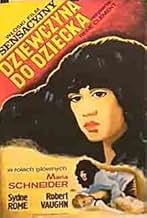VALUTAZIONE IMDb
5,4/10
418
LA TUA VALUTAZIONE
Aggiungi una trama nella tua linguaA naive young girl is forcefully kidnapped while babysitting the son of a wealthy food mogul; she and the boy are held hostage by an ex-stuntman and a vengeful movie star.A naive young girl is forcefully kidnapped while babysitting the son of a wealthy food mogul; she and the boy are held hostage by an ex-stuntman and a vengeful movie star.A naive young girl is forcefully kidnapped while babysitting the son of a wealthy food mogul; she and the boy are held hostage by an ex-stuntman and a vengeful movie star.
Carl Möhner
- Cyrus Franklin
- (as Karl Mohner)
Maria Cumani Quasimodo
- Princess Ruspini
- (non citato nei titoli originali)
Margherita Horowitz
- Maid
- (non citato nei titoli originali)
Trama
Lo sapevi?
- QuizRené Clément's final film at age 62, although he would live another 21 years; it was the last film he directed, and he also wrote it.
Recensione in evidenza
This movie’s BOMB rating in the Leonard Maltin Film Guide seemed to justify distinguished French director Clement’s bowing out of the industry at the relatively early age of 62 (after all, he would go on to live for another 21 years); though admittedly clumsily constructed at times, it’s hardly such an embarrassing mess that would lead a renowned film-maker to become suddenly unbankable!
The bizarre and eclectic international cast is, in itself, quite notable: Maria Schneider, Sydne Rome, Vic Morrow, Robert Vaughn, Nadja Tiller, Renato Pozzetto and Carl Mohner; THE BABYSITTER, in fact, was an Italian-French-German co-production – albeit filmed in English – from Italian movie mogul Carlo Ponti’s stable. While it’s the Americans (Rome, Morrow and Vaughn) who truly make the film, the contributions of Schneider and Pozzetto (both of whom seemed particular liabilities for Maltin!) are hardly negligible or jarring (Schneider’s haunted, disheveled look by the end of it – having been assaulted by Morrow who, in his fury, took a knife to her hair! – and Pozzetto’s surreal ramble to Morrow himself about the apocalyptic inevitability of two-headed insects and radioactive mozzarella bear witness to this). The stunning Rome has a couple of brief, frank nude scenes (one of them at the very start of the film) but, surprisingly enough, Schneider doesn’t (her rebellious and self-destructive nature, which got the actress famously sacked from Luis Bunuel’s THAT OBSCURE OBJECT OF DESIRE [1977], would soon spell the end for her meteoric stardom); incidentally, the two characters meet when Rome is hit by a taxi in which Schneider is a passenger – and the two later decide to shack up together!
Rome, Morrow, Vaughn and Tiller are all down-on-their-luck actors involved in a complex kidnapping scheme actually inspired by Schneider’s titular line of work: in fact, Rome impersonates the latter at the villa belonging to a former conquest – an American industrialist – who had jilted her (the whole, then, is organized by the man’s very own unscrupulous lawyer!); a gruff Morrow doubles as a telephone-repair man in order to move about inconspicuously in the neighborhood of the designated premises, while the customarily brooding Vaughn lends a definite camp factor to the proceedings. Schneider, who’s an unwitting victim here, and the industrialist’s boy start off on the wrong foot (since Rome had mistreated and even drugged him so that he can be transported to an empty house in the suburbs) – but they eventually bond and, by the end, the kid (named Boots!) doesn’t want to leave her side; incidentally, Morrow is forced to kill an elderly neighbor whom Schneider had tried to contact.
Pozzetto, Schneider’s boyfriend, won’t rest on his laurels – also because he gave her the key to his apartment!; somehow, he manages to locate the house but is scared off by Morrow in the above-mentioned scene they share (it was certainly weird seeing the popular, chubby Italian comic interacting with the likes of him and Vaughn) – the film, then, ends on an agreeably amusing note as Pozzetto decides to call in a professional with a passkey to his home (arriving on the scene loaded with them) but, by this time, Schneider’s come back! By the way, the greedy lawyer decides to keep the ransom money all for himself and eliminates Vaughn and Tiller (a scene witnessed by Schneider and the boy); when Morrow turns up, she tells him he’s been duped and he leaves, disconcerted – after which Schneider calls the police to denounce the lawyer’s involvement in the case…
For the record, Clement started out with the famous WWII semi-documentary LA BATAILLE DU RAIL (1945) and proceeded to such Art-house hits as FORBIDDEN GAMES (1952) and GERVAISE (1956); however, after introducing Alain Delon in the excellent Patricia Highsmith adaptation PLEIN SOLEIL (1960), he seemed stuck in a rut of pulp thrillers right till the end of his career – JOY HOUSE (1964), RIDER ON THE RAIN (1970), THE DEADLY TRAP (1971), AND HOPE TO DIE (1972), etc. Incidentally, the film under review had been shown on late-night Italian TV a number of times in the past – but it was only now, still moved by the footage of Morrow’s horrific death, that I decided to check it out…and for which I was glad since, while essentially unsatisfying, it clearly turned out to be of more than passing interest.
The bizarre and eclectic international cast is, in itself, quite notable: Maria Schneider, Sydne Rome, Vic Morrow, Robert Vaughn, Nadja Tiller, Renato Pozzetto and Carl Mohner; THE BABYSITTER, in fact, was an Italian-French-German co-production – albeit filmed in English – from Italian movie mogul Carlo Ponti’s stable. While it’s the Americans (Rome, Morrow and Vaughn) who truly make the film, the contributions of Schneider and Pozzetto (both of whom seemed particular liabilities for Maltin!) are hardly negligible or jarring (Schneider’s haunted, disheveled look by the end of it – having been assaulted by Morrow who, in his fury, took a knife to her hair! – and Pozzetto’s surreal ramble to Morrow himself about the apocalyptic inevitability of two-headed insects and radioactive mozzarella bear witness to this). The stunning Rome has a couple of brief, frank nude scenes (one of them at the very start of the film) but, surprisingly enough, Schneider doesn’t (her rebellious and self-destructive nature, which got the actress famously sacked from Luis Bunuel’s THAT OBSCURE OBJECT OF DESIRE [1977], would soon spell the end for her meteoric stardom); incidentally, the two characters meet when Rome is hit by a taxi in which Schneider is a passenger – and the two later decide to shack up together!
Rome, Morrow, Vaughn and Tiller are all down-on-their-luck actors involved in a complex kidnapping scheme actually inspired by Schneider’s titular line of work: in fact, Rome impersonates the latter at the villa belonging to a former conquest – an American industrialist – who had jilted her (the whole, then, is organized by the man’s very own unscrupulous lawyer!); a gruff Morrow doubles as a telephone-repair man in order to move about inconspicuously in the neighborhood of the designated premises, while the customarily brooding Vaughn lends a definite camp factor to the proceedings. Schneider, who’s an unwitting victim here, and the industrialist’s boy start off on the wrong foot (since Rome had mistreated and even drugged him so that he can be transported to an empty house in the suburbs) – but they eventually bond and, by the end, the kid (named Boots!) doesn’t want to leave her side; incidentally, Morrow is forced to kill an elderly neighbor whom Schneider had tried to contact.
Pozzetto, Schneider’s boyfriend, won’t rest on his laurels – also because he gave her the key to his apartment!; somehow, he manages to locate the house but is scared off by Morrow in the above-mentioned scene they share (it was certainly weird seeing the popular, chubby Italian comic interacting with the likes of him and Vaughn) – the film, then, ends on an agreeably amusing note as Pozzetto decides to call in a professional with a passkey to his home (arriving on the scene loaded with them) but, by this time, Schneider’s come back! By the way, the greedy lawyer decides to keep the ransom money all for himself and eliminates Vaughn and Tiller (a scene witnessed by Schneider and the boy); when Morrow turns up, she tells him he’s been duped and he leaves, disconcerted – after which Schneider calls the police to denounce the lawyer’s involvement in the case…
For the record, Clement started out with the famous WWII semi-documentary LA BATAILLE DU RAIL (1945) and proceeded to such Art-house hits as FORBIDDEN GAMES (1952) and GERVAISE (1956); however, after introducing Alain Delon in the excellent Patricia Highsmith adaptation PLEIN SOLEIL (1960), he seemed stuck in a rut of pulp thrillers right till the end of his career – JOY HOUSE (1964), RIDER ON THE RAIN (1970), THE DEADLY TRAP (1971), AND HOPE TO DIE (1972), etc. Incidentally, the film under review had been shown on late-night Italian TV a number of times in the past – but it was only now, still moved by the footage of Morrow’s horrific death, that I decided to check it out…and for which I was glad since, while essentially unsatisfying, it clearly turned out to be of more than passing interest.
- Bunuel1976
- 10 set 2008
- Permalink
I più visti
Accedi per valutare e creare un elenco di titoli salvati per ottenere consigli personalizzati
- How long is Wanted: Babysitter?Powered by Alexa
Dettagli
- Tempo di esecuzione1 ora 50 minuti
- Mix di suoni
Contribuisci a questa pagina
Suggerisci una modifica o aggiungi i contenuti mancanti

Divario superiore
By what name was Babysitter - Un maledetto pasticcio (1975) officially released in Canada in English?
Rispondi































